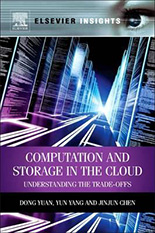Computation and Storage in the Cloud: Understanding the Trade-Offs
 Authors: Dong Yuan, Yun Yang, Jinjun Chen
Authors: Dong Yuan, Yun Yang, Jinjun Chen
Pages: 128
Publisher: Elsevier
ISBN: 0124077676
Introduction
These days, especially in the IT world, most people are familiar with the concept of cloud computing and they take advantage of it for a variety of personal and business reasons. But not many realize the huge benefits that come from using it for scientific research. The cloud is a new way for researchers to deploy data-intensive applications without any infrastructure. This book looks into the computation and storage trade-off in the cloud.
About the authors
Dong Yuan is a postdoctoral research fellow in the Centre for Computing and Engineering Software Systems, Swinburne University of Technology.
Yun Yang received a Master of Engineering degree from The University of Science and Technology of China.
Jinjun Chen is an Associate Professor in the Faculty of Engineering and Information Technology, University of Technology, Sydney, Australia.
Inside the book
One of the most prominent cloud computing selling points is definitely cost-effectiveness. After getting through this book and the substantial number of examples, you’re definitely going to have an idea of what to expect. Naturally, this is aimed at users that need a substantial amount of storage and computing power, not regular users that take advantage of a few gigabytes for backing up.
When it comes to scientific applications in the cloud and calculating costs, the authors present their own static on-demand benchmarking and dynamic on-the-fly benchmarking approaches with algorithms for the best trade-off between storage and computation.
The suggested storage strategies and benchmarks are tested using SwinCloud – a cloud computing simulation environment built at Swinburne University of Technology. They detail the hardware and software configurations which makes it easy to put all the data into context when evaluating a cloud provider and its offerings.
Do you store all data sets or none? Do you just store a certain percentage of what you use often? Which storage strategy is right for your needs? These are just some of the questions that the authors answer with a great deal of context.
Final thoughts
Overall, this book does a good job at tackling a variety of complex subjects. It brings forward state-of-the-art concepts and elaborate algorithms, illustrates issues related to cost-effectiveness, and helps both cloud providers and users get a grip on the intricate world of cloud computing.
